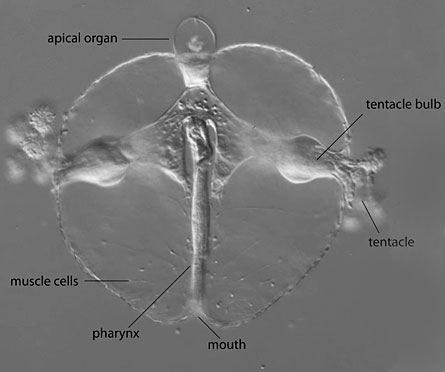Every horror flick fan knows to never underestimate a blob. Now, scientists working with comb jellies have learned the same lesson. Within the transparent ooze of the gelatinous animal, researchers have found startling genetic complexity. It’s as if they’ve discovered that igloos were based on blueprints for the Sydney Opera House.


No one suspected that the primitive comb jellies — watery, rotund and nearly invisible sea creatures — would rely on an intricate interplay of genes to design their rudimentary bodies. Yet researchers got a surprise when they looked at the comb jelly’s genes. Scientists found pattern-making genes that, in most animals, plot out the position of the head, brain, limbs and rear ends during development. These “homeobox” genes turned on in a specific pattern in the comb jellies, even though these ancient sea creatures are headless, brainless, limbless and rear end–less, scientists show in the June Development Genes and Evolution.
This perplexing discovery suggests that simple creatures have more going on genetically than what meets the eye. It also suggests that genes that play similar roles in most animals perform very different functions in comb jellies or may not produce any visible outcomes at all.
“Nature is rubbing it in our faces that we don’t know what’s going on,” says Mark Martindale, a developmental biologist at Kewalo Marine Lab in Honolulu, Hawaii.
Over a decade ago, scientists established that members of the homeobox gene family pattern an animal’s body plan as it develops from a generic ball of cells into a recognizable embryo with tissue layers, parts and organs. In mice, frogs and flies, for example, embryonic cells with active otx homeobox genes may later form the brain. And a heart often develops where Nk homeobox genes turn on in mice, flies and worms.
Researchers hypothesize that the homeobox genes form a genetic toolkit that specifies body plans in all animals, and that the toolkit is inherited from a common ancestor who used those genes in a similar manner. But if and how the toolkit functioned in an even earlier ancestor, who had neither head nor rear, has been a mystery. As headless descendants of one of the first animal groups, living comb jellies provide a window into the past.
Learning how these gelatinous creatures use the genetic toolkit has been notoriously difficult. “Many comb jellies turn to goo the minute you collect them,” comments biologist Casey Dunn at BrownUniversity in Providence, R.I.
After years of labor, Kevin Pang, a graduate student with Martindale’s group, identified regions of the body in which seven homeobox genes were active in the fragile comb jelly Mnemiopsis leidyi. Before the experiments, he didn’t know what to expect. “They aren’t like other animals,” he says, “there’s just a mouth, tentacles — that’s mainly it.”
Certain genes expressed in the mouths of comb jellies and in the heads of other animals could indicate that the comb jellies’ mouths correspond to the front-end of all animals (except for amorphous sponges), Martindale says. And it implies that the mouth region of an ancestral headless animal is in the same area where the first head eventually arose. Although comb jellies are using the same basic toolkit as other animals, they might be doing so in an entirely different way, Martindale says. Genes involved with limb formation in other animals were expressed at seemingly random points along the comb jellies’ throat-like pharynx, for example.
“Mice, flies and even cnidarians [jellyfish and sea anenomes, mainly] seem to be built on the same basic plan, but the sponges and comb jellies don’t fall into that mold,” Martindale says.
Dunn notes that this study shows the foolishness of assuming that simple-looking animals at the base of the tree use simple toolkits. He stresses that scientists need to take a closer look: “The more we fill in the tree branch by branch with data on multiple genes, the more we’ll be able to understand animal evolution.”






